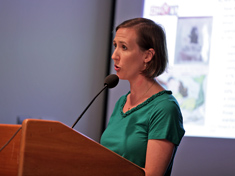-
Elizabeth Berard on Reaching Adolescent Boys Living With HIV/AIDS
September 19, 2014 By Heather Randall
Adolescent boys are 75 percent more likely to die from HIV/AIDS than girls. Why? That’s unclear. Lack of data and failure to engage boys in discussions about sexual and reproductive health and HIV care has left many suffering, says Elizabeth Berard, a health science specialist with the U.S. Agency for International Development, in this week’s podcast.
Adolescent boys are 75 percent more likely to die from HIV/AIDS than girls. Why? That’s unclear. Lack of data and failure to engage boys in discussions about sexual and reproductive health and HIV care has left many suffering, says Elizabeth Berard, a health science specialist with the U.S. Agency for International Development, in this week’s podcast.
While preparing to speak at the Wilson Center, Berard says she was struck by how little information is available about adolescent boys with HIV/AIDS. A 2012 report from UNICEF states that of the 2.2 million adolescents (between 10 and 19 years old) living with HIV, approximately 870,000 of them are boys. And that’s about it.
Not only is there little data overall, but what is collected has not been aggregated, she says. “There are a variety of different numbers that are floating out there, some for 15 to 19 years old, some for 15 to 24 year olds, others that are just somewhere in between.”
Different Genders, Different Needs
Addressing this data gap is key. Berard notes that adolescent boys living with HIV are more likely to have been infected at birth and as a result face different challenges than adolescents who have contracted HIV behaviorally (many young girls contract the disease from their partners – new infection rates for women between 15 and 24 years old are double that of men).
Adolescent boys also have fewer ways to access care. “Many women, regardless of age, find out they’re living with HIV only because of antenatal care,” Berard says. That leaves young boys with fewer opportunities to get tested and receive treatment.
Cultural, religious, and traditional norms in many places limit the ability of young people to have open conversations about sexual and reproductive health generally, Berard says. This has a significant impact on their understanding of HIV transmission and care as well as the need to adhere to strict treatment regimens. In 2013, only 29 percent of youth in 157 countries had comprehensive knowledge of HIV/AIDS, according to the Population Reference Bureau.
Improving HIV outreach and treatment for adolescent boys requires unique programs that engage boys in conversations about sexual and reproductive health in culturally and youth-appropriate ways, Berard says.
She suggests a variety of interventions to get more boys into clinics, including family testing, voluntary male medical circumcision, couples’ testing, and targeting specific vulnerable groups, such as orphans, young men who have sex with men, and adolescents diagnosed with tuberculosis or malnutrition, which could be symptoms of HIV infection.
Berard spoke at the Wilson Center on July 30. Download her slides to follow along.
Friday podcasts are also available for download on iTunes.
 A Publication of the Stimson Center.
A Publication of the Stimson Center.




